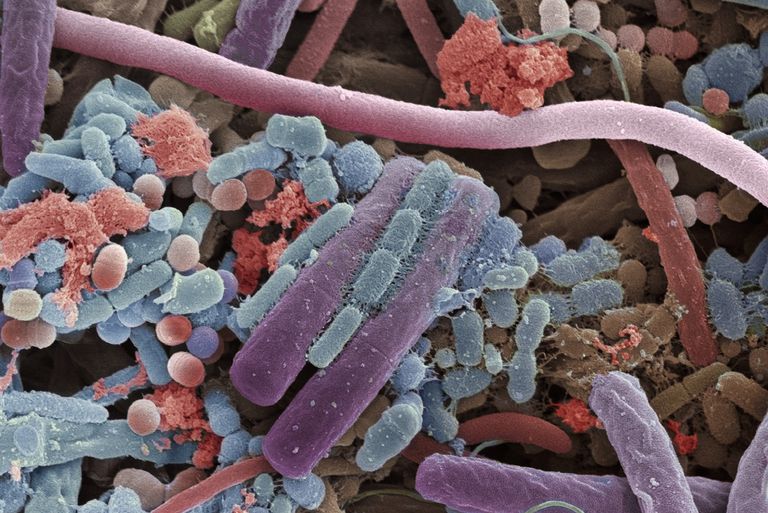Bacteria and viruses are both microscopic organisms that can cause disease in humans. While these microbes may have some characteristics in common, they are also very different. Bacteria are typically much larger than viruses and can be viewed under a light microscope. Viruses are about 1,000 times smaller than bacteria and are visible under an electron microscope. Bacteria are single-celled organisms that reproduce asexually independently of other organisms.
Viruses require the aid of a living cell in order to reproduce.
WHERE ARE THEY FOUND?
Bacteria: Bacteria live almost anywhere including within other organisms, on other organisms, and on inorganic surfaces. Some bacteria are considered to be extremophiles and can survive in extremely harsh environments such as hydrothermal vents and in the stomachs of animals and humans.
Viruses: Much like bacteria, viruses can be found in almost any environment. They can infect animals and plants, as well as bacteria and archaeans. Viruses that infect extremophiles such as archaeans have genetic adaptations that enable them to survive harsh environmental conditions (hydrothermal vents, sulpuric waters, etc.). Viruses can persist on surfaces and on objects we use everyday for varying lengths of time (from seconds to years) depending on the type of virus.
BACTERIAL AND VIRAL STRUCTURE
Bacteria: Bacteria are prokaryotic cells that display all of the characteristics of living organisms.
Bacterial cells contain organelles and DNA that are immersed within the cytoplasm and surrounded by a cell wall. These organelles perform vital functions that enable bacteria to obtain energy from the environment and to reproduce.
Viruses: Viruses are not considered cells but exist as particles of nucleic acid (DNA or RNA) encased within a protein shell.
Also known as virions, virus particles exist somewhere between living and non-living organisms. While they contain genetic material, they don’t have a cell wall or organelles necessary for energy production and reproduction. Viruses rely solely on a host for replication.
SIZE AND SHAPE
Bacteria: Bacteria can be found in a variety of shapes and sizes. Common bacterial cell shapes include cocci (spherical), bacilli (rod-shaped), spiral, and vibrio. Bacteria typically range in size from 200-1000 nanometers (a nanomerter is 1 billionth of a meter) in diameter. The largest bacterial cells are visible with the naked eye. Considered the world’s largest bacteria, Thiomargarita namibiensis can reach up to 750,000 nanometers (0.75 millimeters) in diameter.
Viruses: The size and shape of viruses is determined by the amount of nucleic acidand proteins they contain. Viruses typically have spherical (polyhedral), rod-shaped, or helical shaped capsids. Some viruses, such as bacteriophages, have complex shapes which include the addition of a protein tail attached to the capsid with tail fibers extending from the tail. Viruses are much smaller than bacteria. They generally range in size from 20-400 nanometers in diameter.
The largest viruses known, the pandoraviruses, are about 1000 nanometers or a full micrometer in size.
HOW DO THEY REPRODUCE?
Bacteria: Bacteria commonly reproduce asexually by a process known as binary fission. In this process, a single cell replicates and divides into two identical daughter cells. Under proper conditions, bacteria can experience exponential growth.
Viruses: Unlike bacteria, viruses can only replicate with the aid of a host cell. Since viruses don’t have the organelles necessary for the reproduction of viral components, they must use the host cell’s organelles to replicate. In viral replication, the virus injects its genetic material (DNA or RNA) into a cell. Viral genes are replicated and provide the instructions for the building of viral components. Once the components are assembled and the newly formed viruses mature, they break open the cell and move on to infect other cells.
DISEASES CAUSED BY BACTERIA AND VIRUSES
Bacteria: While most bacteria are harmless and some are even beneficial to humans, other bacteria are capable of causing disease. Pathogenic bacteria that cause diseaseproduce toxins that destroy cells. They can cause food poisoning and other serious illnesses including meningitis, pneumonia, and tuberculosis. Bacterial infections can be treated with antibiotics, which are very effective at killing bacteria. Due to the overuse of antibiotics however, some bacteria (E.coli and MRSA) have gained resistance to them. Some have even become known as superbugs as they have gained resistance to multiple antibiotics. Vaccines are also useful in preventing the spread of bacterial diseases. The best way to protect yourself from bacteria and other germs is to properly wash and dry your hands often.
Viruses: Viruses are pathogens that cause a range of diseases including chickenpox, the flu, rabies, Ebola virus disease, Zika disease, and HIV/AIDS. Viruses can cause persistent infections in which they go dormant and can be reactivated at a later time. Some viruses can cause changes within host cells that result in the development of cancer. These cancer viruses are known to cause cancers such as liver cancer, cervical cancer, and Burkitt’s lymphoma. Antibiotics do not work against viruses. Treatment for viral infections typically involve medicines that treat the symptoms of an infection and not the virus itself. Typically the immune system is relied upon to fight off the viruses.
Vaccines can also be used to prevent viral infections.














